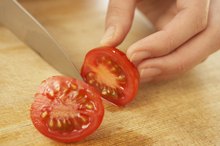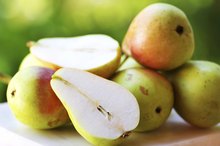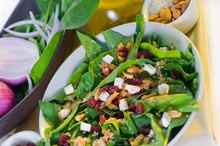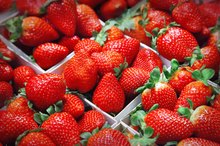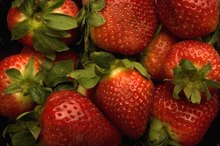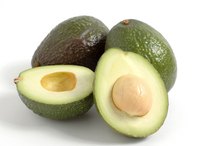Fruits That Contain Glycolic Acid
Glycolic acid is most often associated with skin care, but it's also a natural acid found in a variety of fruits. In addition to lending a certain amount of tartness to some of your favorite fruits, glycolic acid helps fruit grow and mature, and it may help protect the fruit from bacteria. Glycolic acid isn't an essential nutrients, but glycolic acid-rich fruits offer other nutrients that benefit your health.
Berries
Although citric acid is the primary acid found in these two fruits, both strawberries and blueberries are a source of glycolic acid. The exact amount of glycolic acid in the berries is unknown, according to food ingredient company Hawkins Watts, and may vary depending on ripeness and season.
There are no known health benefits to ingesting glycolic acid, but berries have other beneficial nutrients. Blueberries, for example, have more antioxidant activity than any other fruit, according to Canadian Living, and eating them may help reduce your risk of developing illnesses such a Alzheimer's.
- Although citric acid is the primary acid found in these two fruits, both strawberries and blueberries are a source of glycolic acid.
- Blueberries, for example, have more antioxidant activity than any other fruit, according to Canadian Living, and eating them may help reduce your risk of developing illnesses such a Alzheimer's.
Cherries
List of Nightshade Vegetables & Fruits
Learn More
Cherries are also a source of glycolic acid, although the primary acid in them is malic acid. Cherries, especially the sour ones, are rich in anthoycanins, which are antioxidants that may help reduce inflammation and are also associated with easing pain caused by gout or other forms of arthritis.
Unripe Grapes
Grapes that haven't ripened are also a source of glycolic acid. While it's safe to eat unripe grapes, you might not enjoy the taste of the sour fruit 5. However, these types of grapes are used to make a sour molasses. As the grapes ripen, the glycolic acid in the fruit decreases, explains Wilhelm Pfeffer, author of "The Physiology of Plants. 4"
Eating Tips
How Many Calories Does a Pear Have?
Learn More
You can easily incorporate these foods into your diet plan if you're trying to up your intake of glycolic acid. Blueberries make a sweet addition to any whole-grain breakfast cereal or plain nonfat Greek yogurt. Blend strawberries in with your fruit smoothie or add a few slices to a garden salad. Cherries are delicious by themselves as a snack, or you can pit and slice them and add to whole-grain pancake or muffin batter. You can slice sour grapes and mix them into a sweet fruit salad to balance flavor, or dice the grapes and add them to a spicy salsa.
- You can easily incorporate these foods into your diet plan if you're trying to up your intake of glycolic acid.
- Cherries are delicious by themselves as a snack, or you can pit and slice them and add to whole-grain pancake or muffin batter.
Related Articles
References
- Drugs.com: Fruit Acids
- Canadian Living: The Top 25 Healthy Fruits
- The Physiology of Plants; Wilhelm Pfeffer
- The Atlantic: The Allure of Unripe Fruit
- National Institutes of Health PubChem. Glycolic acid. Updated February 1, 2020.
- Tang SC, Yang JH. Dual effects of alpha-hydroxy acids on the skin. Molecules. 2018;23(4):863. doi:10.3390/molecules23040863
- Fabbrocini G, Annunziata MC, D'Arco V, et al. Acne scars: pathogenesis, classification and treatment. Dermatol Res Pract. 2010;2010:893080. doi:10.1155/2010/893080
- U.S. Food and Drug Administration. Alpha hydroxy acids. Updated May 7, 2019.
- Al-Talib H, Al-Khateeb A, Hameed A, Murugaiah C. Efficacy and safety of superficial chemical peeling in treatment of active acne vulgaris. An Bras Dermatol. 2017;92(2):212–216. doi:10.1590/abd1806-4841.20175273
- Abels C, Reich H, Knie U, Werdier D, Lemmnitz G. Significant improvement in mild acne following a twice daily application for 6 weeks of an acidic cleansing product (pH 4). Journal of Cosmetic Dermatology. 2014;13(2):103-8. doi:0.1111/jocd.12086
- Kaminaka C, Uede M, Matsunaka H, Furukawa F, Yamomoto Y. Clinical evaluation of glycolic acid chemical peeling in patients with acne vulgaris: a randomized, double-blind, placebo-controlled, split-face comparative study. Dermatological Surgery. 2014;40(3):314-22. doi:10.1111/dsu.12417
- Sharad J. Glycolic acid peel therapy - a current review. Clinical Cosmetic and Investigational Dermatology. 2013;6:281-8. doi:10.2147/CCID.S34029
- Takenaka Y, Hayashi N, Takeda M, Ashikaga S, Kawashima M. Glycolic acid chemical peeling improves inflammatory acne eruptions through its inhibitory and bactericidal effects on Propionibacterium acnes. Journal of Dermatology. 2012;39(4):350-4. doi:10.1111/j.1346-8138.2011.01321.x
Writer Bio
Jill Corleone is a registered dietitian and health coach who has been writing and lecturing on diet and health for more than 15 years. Her work has been featured on the Huffington Post, Diabetes Self-Management and in the book "Noninvasive Mechanical Ventilation," edited by John R. Bach, M.D. Corleone holds a Bachelor of Science in nutrition.
